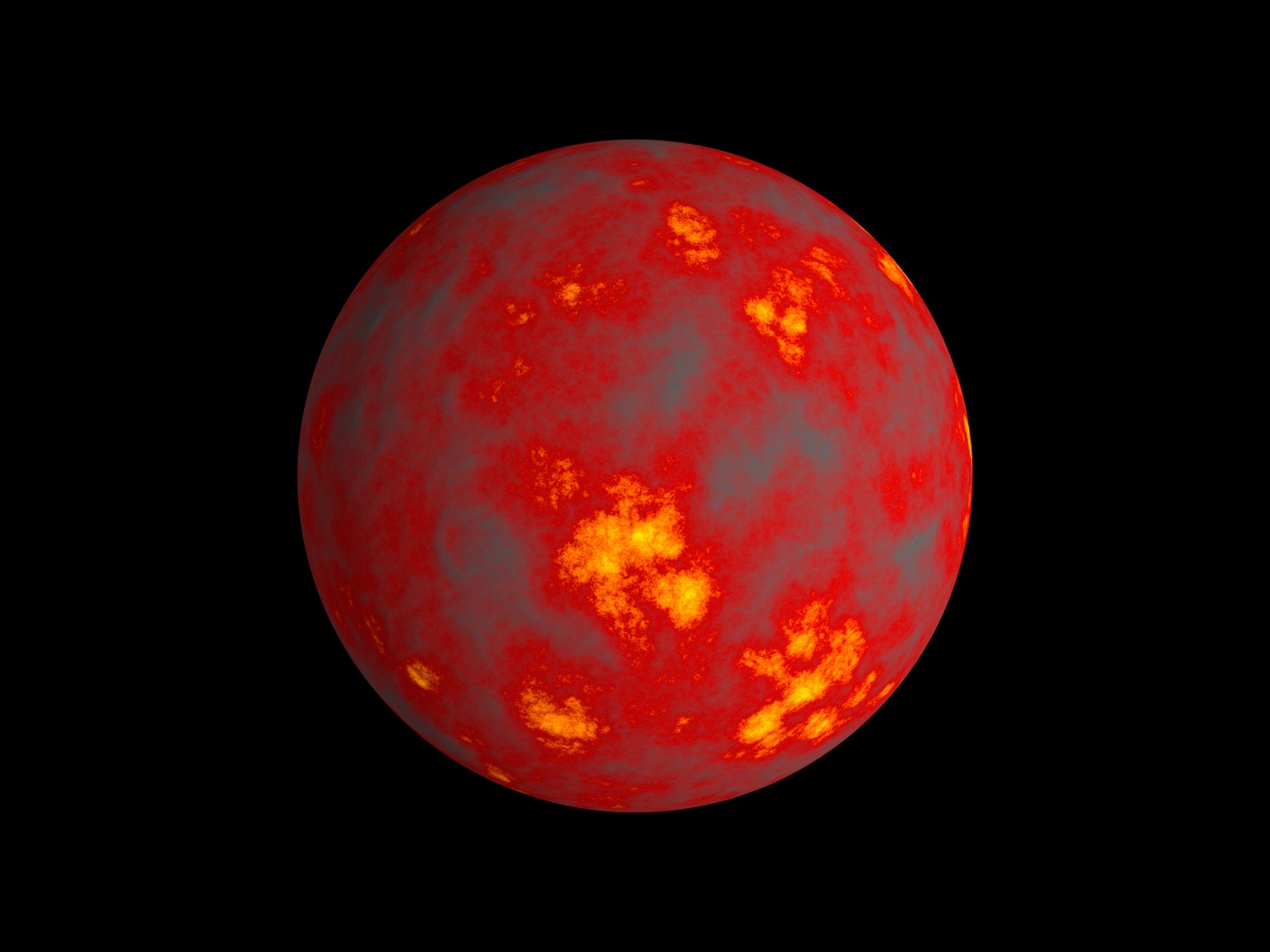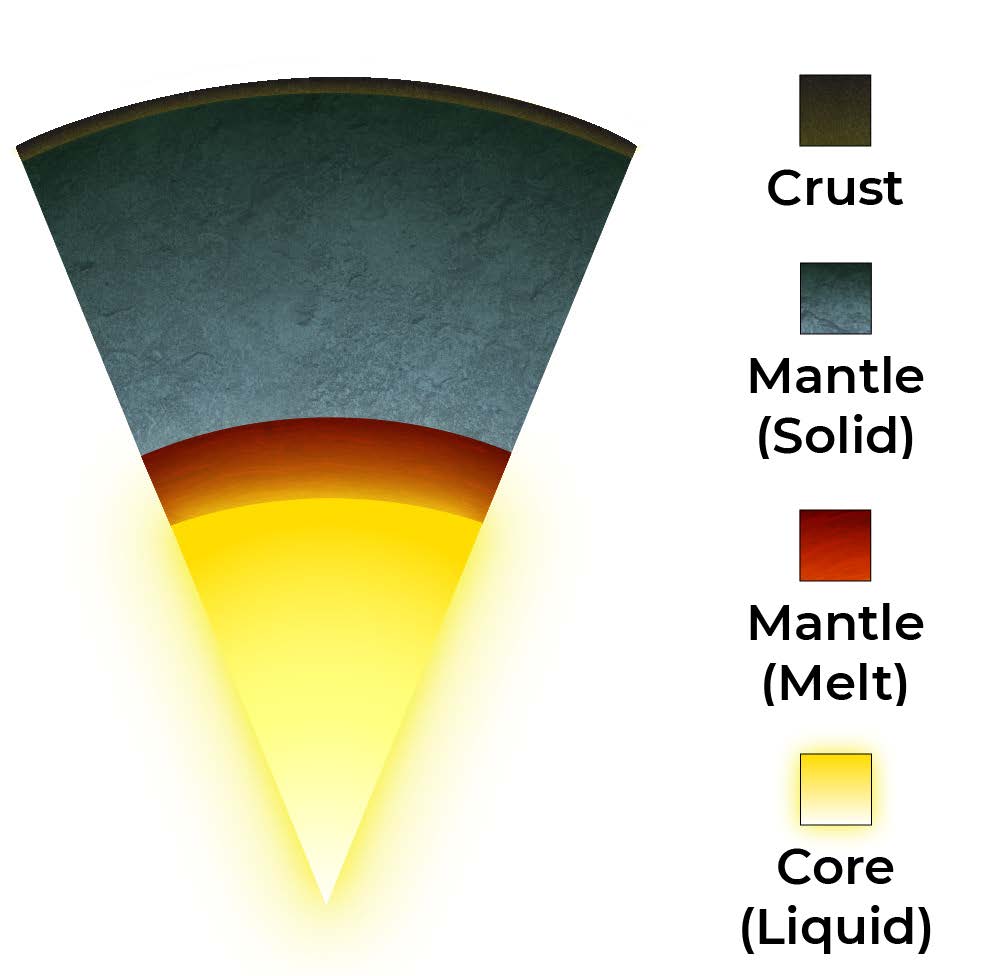
Credit: Merikanto, CC BY-SA 4.0, via Wikimedia Commons
In the beginning, Earth was hell.
The planet was completely molten, a roiling sea of magma at temperatures of thousands of degrees. Scientists even referenced Hades to name this period: Hadean Earth.
How did it become the green paradise we know today? Well, over about half a billion years, it cooled. And how it cooled has shaped some important traits of Earth to this day. Logically then, scientists are studying what happened.
They use seismic waves from natural earthquakes and man-made explosions to map today’s inner Earth. And they’re using theoretical modeling to study its ancient past, which suggests that Earth cooled like this:
Very hot surface material, in contact with an early atmosphere, began to cool first.
Convection currents carried warmer magma from Earth’s center up toward the surface and forced cooler material back down.
Metals and elements attracted to iron sunk out of the current to form a central iron and nickel core.
The mantle between surface and core began to cool next, while the lowermost mantle remained liquid.
Scientists think this basal magma ocean had strong fluid currents within it, which may have converted kinetic energy into electromagnetic energy. This could have helped start Earth’s geodynamo—which today generates Earth’s magnetic field from its metal core.
But as with all science, this research is ongoing—so expect updates on a future EarthDate.
Background
Synopsis: In the earliest days of Earth’s history, at the start of the Hadean Eon, our planet was a roiling sphere of liquefied rock and metal with temperatures of thousands of degrees. This molten planet differentiated into layers of core, mantle and, eventually, crust. Researchers use remote sensing and modeling to better understand how the lowermost mantle may have influenced the creation of the geodynamo on Earth and possibly on other rocky planets, also.
- While the universe is about 13.7 billion years old, our solar system started forming about 4.57 billion years ago when a dense cloud of interstellar dust and gas collapsed to produce a spinning solar nebula.
- Gravity pulled material inward to create the nuclear fusion reactor that is our Sun.
- Earth coalesced from the cloud swirling around the Sun about 4.54 billion years ago, initiating the first of Earth’s geological eons, the Hadean Eon.
- The Hadean, named for Hades, the Greek god of the underworld, was a time of dramatic change. The molten Earth’s surface temperature could have initially exceeded 2,000 K (3,140°F, 1,727°C), and its gravity attracted frequent collisions with planetesimals.
- Other rocky planets, like Mars, Venus and Mercury, also started out molten.
- The collision of Earth with Theia, a Mars-sized planetary body, formed Earth’s moon during the Hadean Eon. During formation, the Moon was so hot that its entire mantle was molten magma.
- The Hadean Eon ended approximately 4 billion years ago, by which time Earth had water oceans and a surface temperature not much different from today’s.
- With the constant recycling of Earth’s crust by plate tectonics, which started about 3.2 billion years ago, Hadean rocks are very rare. The oldest solid materials known on Earth are 4.404 billion-year-old zircon crystals found in the Jack Hills of Western Australia.
- During the first part of the Hadean Eon, Earth was covered in a magma ocean, molten rock with suspended solid crystals floating in a gassy, lavalike fluid that extended all the way to the planet’s core.
- Convection currents brought warmer melt to the surface as cooler material descended into the roiling magma ocean.
- Metals and heavier elements descended in these currents to form Earth’s solid metallic inner core, primarily made of iron and nickel, and the liquid outer core that sustains Earth’s magnetic field, known as the geodynamo.
- Samples of anorthosites from the Apollo lunar missions show that our Moon (and other rocky planets) followed similar histories. The light-colored part of the moon, as seen from Earth, consists of these rocks, which can only form as crystals fractionate, floating to the top of large volumes of magma.
- Unlike the Moon, Earth does not have a flotation crust. Earth’s crust forms from partial melting of the mantle.
- Today, magma oceans are widely accepted to be a critical stage in the evolution of rocky planets.
- As Earth’s mantle cooled, it is thought to have solidified from the middle outward.
- With the large temperature gradient at its surface, the magma ocean would have cooled by transferring heat from deep in its interior to the atmosphere, eventually crystallizing into a mush.
- Recent studies have shown that, at the pressures and temperatures of the lower mantle, magma liquids become progressively more iron rich and may actually be denser than the solids.
- These liquids are thought to have collected just above the core, forming an iron-rich molten layer known as a basal magma ocean (BMO).

Possible internal structures of terrestrial planets and rocky moons early in their histories when temperatures were still hot enough that both the core and the lowermost mantle were molten.
Credit: Adapted from O’Rourke et al. (2023), with acknowledgment to P. K. Byrne for the original figure. - The solid mantle layer would continue to grow both upward and downward as it continued cooling, while convection currents continued to operate in the molten layers.
- Research currently underway at the University of Texas Institute for Geophysics by Krista Soderlund and her colleague Joe O’Rourke, at Arizona State University, is focused on learning about the influence of these BMO currents on the history of Earth’s geodynamo, which is currently generated by convection in the Earth’s molten outer core.
- Geophysicists are able to map the present-day structure of Earth’s interior using seismic waves from earthquakes and explosions. Theoretical geophysicists model Earth processes to better understand our planet.
- Similar to fluid currents in our oceans and atmosphere, researchers believe these mantle convection currents were modified by Earth’s rotation. What did these modified magma currents look like, and how did they operate?
- Currents in the lowermost mantle may have contributed to the creation of Earth’s magnetic field, through the conversion of kinetic energy to magnetic energy (a dynamo). In order for a dynamo to keep running, the magma must have relatively high electrical conductivities so that it can “hold onto” a magnetic field rather than let it diffuse away. How might mantle BMO currents have contributed to the creation of Earth’s outer core-based geodynamo? What about other rocky planets and the moon?
- Researchers will explore these questions about the genesis of Earth’s life-sustaining magnetic field using models of the planet’s interior and report back about the thought processes they used to approach this abstract subject and the results they achieved in a future EarthDate episode.

